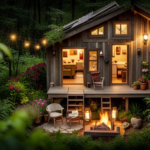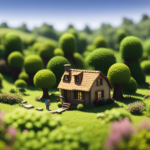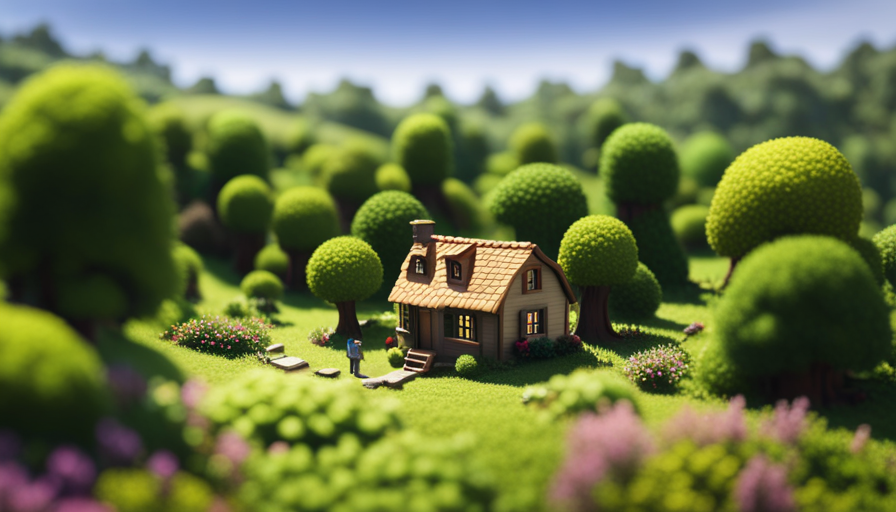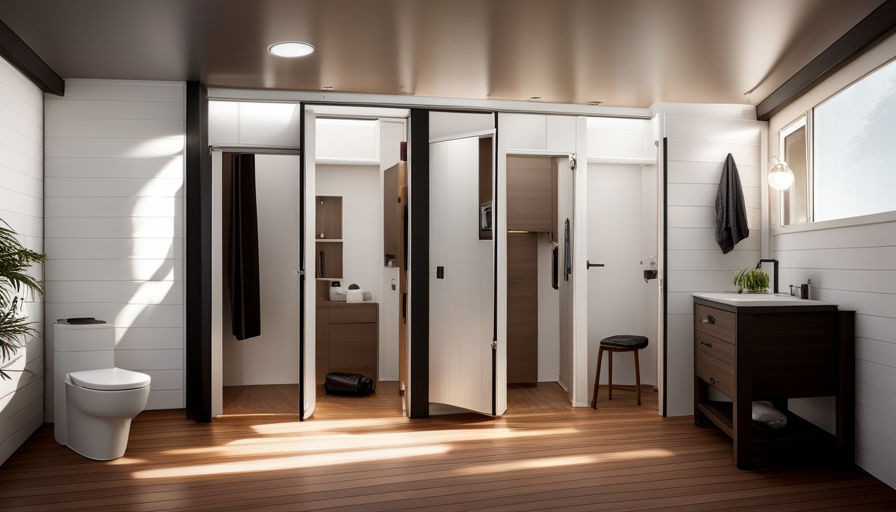So you have decided to join the tiny house community, correct? Get ready to downsize your living space while improving your quality of life. In this article, I will be your guide into the world of tiny living, where having less clearly means having more.
Imagine a life where you can fit all your belongings into a space no bigger than a walk-in closet. A life where simplicity reigns supreme, and every square inch of your home serves a purpose. It may sound daunting at first, but trust me, the benefits are endless.
From financial freedom to a reduced carbon footprint, tiny living offers a unique and fulfilling way of life. But before you embark on this adventure, there are a few things you need to know. We’ll explore everything from finding the perfect location for your tiny house to navigating legal and zoning regulations.
We’ll also dive into the art of maximizing space and storage solutions, embracing minimalism and decluttering, and creating a functional and stylish interior.
So, buckle up and get ready to learn how to tiny house like a pro. Your journey to a simpler, more intentional life starts here.
Key Takeaways
- The tiny house movement is a growing trend that promotes living in small, sustainable homes.
- Tiny living offers numerous benefits, including reduced expenses, a smaller carbon footprint, and the opportunity to live a more minimalist lifestyle.
- Financing options for tiny house projects can include personal savings, loans, crowdfunding, or partnerships.
- When choosing a location for a tiny house, it is important to consider zoning regulations, access to utilities, and the overall suitability of the area.
Explore the Benefits of Tiny Living
One of the key advantages of tiny living is that it allows individuals to simplify their lives and focus on what truly matters. Living in a tiny house promotes a sustainable lifestyle, as it encourages minimizing waste, reducing energy consumption, and utilizing renewable resources.
With a smaller space to maintain, there is less need for excessive material possessions, leading to a more eco-friendly way of living. Additionally, the financial savings associated with tiny living are substantial. Tiny houses are significantly cheaper to build and maintain compared to traditional houses. The reduced size means lower utility bills, lower property taxes, and less money spent on home repairs and maintenance.
Furthermore, tiny living offers an opportunity to pay off debt or save money for other financial goals, such as traveling or starting a business. By simplifying their living space, individuals can free up resources to invest in experiences and relationships that bring true fulfillment.
Now that we’ve explored the benefits of tiny living, it’s important to determine your budget and financing options.
Determine Your Budget and Financing Options
To figure out the cost and explore different ways to fund your minimalist dream, it’s essential to carefully evaluate your budget and consider various financing options. Budgeting for a tiny house may seem challenging, but it can be done with proper planning and research. Here are some budgeting tips to help you get started:
-
Determine your total budget: Calculate the maximum amount you can afford to spend on your tiny house project. Consider factors such as your income, savings, and any potential loans or grants you may qualify for.
-
Break down your expenses: Make a detailed list of all the costs involved in building or buying a tiny house. This includes materials, labor, permits, land, utilities, and any additional features or upgrades you desire.
-
Prioritize your expenses: Determine what aspects of your tiny house are essential and what can be compromised or postponed. This will help you allocate your budget more effectively.
When it comes to financing options, there are several routes you can take. Some popular choices include personal savings, loans from family or friends, personal loans from financial institutions, or crowdfunding platforms. Each option has its own advantages and considerations, so it’s crucial to research and compare them to find the best fit for your situation.
As you finalize your budget and financing plan, keep in mind that it’s essential to stay realistic and flexible. Unexpected expenses may arise, so having some wiggle room in your budget is advisable. With a solid budget and financing plan in place, you can confidently move forward with finding the perfect location for your tiny house, where you can truly make your minimalist dream a reality.
Find the Perfect Location for Your Tiny House
Discovering the ideal spot for your compact haven will ignite a sense of excitement and anticipation within you.
When it comes to finding the perfect location for your tiny house, there are a few factors to consider. One option is to join a tiny house community, where like-minded individuals come together to create a supportive and sustainable environment. These communities often offer shared amenities and resources, such as communal gardens and workshops, fostering a sense of community and belonging.
Another option is off-grid living, which allows you to disconnect from traditional utilities and live self-sufficiently. This might involve finding a remote piece of land where you can install solar panels, collect rainwater, and practice sustainable living.
Regardless of the route you choose, it’s important to research local zoning laws and regulations to ensure that you can legally park or build your tiny house in your desired location.
Once you’ve found the perfect spot, you can transition into the subsequent section about designing and customizing your tiny home, where you can turn your vision into a reality.
Design and Customize Your Tiny Home
Get ready to unleash your creativity and transform your compact haven into a jaw-dropping masterpiece that’ll make your heart skip a beat. Designing and customizing your tiny home is an exciting process that allows you to maximize every inch of space while reflecting your personal style.
Here are some design tips to help you create a functional and beautiful tiny house:
-
Multifunctional Furniture: Opt for furniture pieces that serve multiple purposes, such as a bed with built-in storage or a dining table that can be folded down when not in use. This’ll help you make the most of your limited space.
-
Use Natural Light: Incorporate large windows or skylights to bring in ample natural light, making your tiny house feel more spacious and inviting. Additionally, consider using light-colored paint or wallpaper to enhance the brightness.
-
Sustainable Materials: Embrace sustainability by using eco-friendly materials like reclaimed wood, bamboo flooring, or recycled countertops. This not only reduces your environmental footprint but also adds a unique touch to your tiny home.
-
Vertical Storage: Utilize vertical space by installing shelves, wall-mounted cabinets, or hanging organizers. This’ll help you keep your belongings organized and free up valuable floor space.
Now that you have some design tips and sustainability options for your tiny home, it’s time to navigate legal and zoning regulations to ensure your project complies with local laws and regulations.
Navigate Legal and Zoning Regulations
Once you’ve unleashed your creativity and transformed your compact haven into a jaw-dropping masterpiece, it’s time to navigate the legal and zoning regulations to ensure your tiny home complies with local laws and regulations.
Understanding building codes and obtaining necessary permits are crucial steps to take in this process. Building codes are regulations that dictate the minimum standards for construction and safety. Each jurisdiction may have its own specific codes, so it’s important to research and understand the requirements in your area. These codes cover various aspects such as structural integrity, electrical systems, plumbing, and fire safety. Adhering to these codes will not only ensure the safety of your tiny home but also prevent any potential legal issues in the future.
Obtaining necessary permits is another essential aspect of complying with regulations. Different permits may be required depending on the scope of your project, including construction permits, electrical permits, and plumbing permits. It’s crucial to consult with your local building department to determine the specific permits needed and to ensure that all necessary inspections are conducted throughout the construction process.
By understanding building codes and obtaining the necessary permits, you can ensure that your tiny home meets all legal and zoning regulations. This will give you peace of mind and prevent any setbacks or fines.
Now that you have a solid foundation in navigating the legal aspects, let’s move on to the next step and explore how to choose the right materials and construction methods for your tiny home.
Choose the Right Materials and Construction Methods
Now that we’ve covered how to navigate legal and zoning regulations, let’s move on to the next step in building a tiny house: choosing the right materials and construction methods. This is a crucial aspect of tiny house construction as it directly affects the sustainability and eco-friendliness of your home.
When it comes to materials, opt for sustainable options such as reclaimed wood, recycled metal, or bamboo. These choices not only reduce the environmental impact but also add a unique touch to your tiny house. Additionally, consider using eco-friendly insulation materials like sheep’s wool or recycled denim.
In terms of construction methods, there are several options to explore. One popular method is using prefabricated panels, which aren’t only easy to assemble but also reduce waste and construction time. Another approach is timber framing, which provides a sturdy structure while allowing for flexibility in design.
To make the writing more enjoyable and relatable, here are some nested bullet point lists:
-
Sustainable materials:
- Reclaimed wood
- Recycled metal
- Bamboo
-
Eco-friendly construction methods:
- Prefabricated panels
- Timber framing
By choosing the right materials and construction methods, you can create a tiny house that isn’t only environmentally friendly but also aesthetically pleasing. Now, as we move on to the next section on how to maximize space and storage solutions, let’s explore innovative techniques to make the most of your tiny house’s limited square footage.
Maximize Space and Storage Solutions
To truly optimize your living space and find clever storage solutions, it’s all about thinking creatively and making the most of every nook and cranny.
When it comes to tiny house living, every square inch counts. One of the best ways to maximize space is by investing in space-saving furniture. Look for multi-functional pieces that can serve multiple purposes, such as a sofa that can also be converted into a bed, or a dining table that can be folded down when not in use.
Additionally, consider utilizing vertical space by installing shelves or hanging organizers on the walls. This will help keep your belongings off the floor and free up valuable floor space.
Creative organization is also key in a tiny house. Utilize storage solutions that make the most of every inch, such as under-bed storage bins or hanging organizers inside closets. Make use of hidden storage compartments, such as ottomans with hidden compartments or bed frames with built-in drawers. Think outside the box and find unique ways to store your belongings, such as using mason jars or hanging shoe organizers for small items.
Incorporating these space-saving furniture and creative organization techniques will help you make the most of your tiny house. By maximizing space and finding clever storage solutions, you can create a functional and organized living environment.
Transitioning into the subsequent section about ’embrace minimalism and decluttering’, it’s important to remember that these strategies go hand in hand with the goal of a tiny house lifestyle.
Embrace Minimalism and Decluttering
Embracing minimalism and decluttering allows for a liberating sense of freedom and a renewed appreciation for the things that truly matter in life. Adopting a minimalist lifestyle means simplifying your surroundings and focusing on what’s essential.
Here are some organizing tips to help you on your journey:
-
Start with a clean slate: Before you begin decluttering, clear out all the unnecessary items from your tiny house. This’ll give you a fresh start and make it easier to organize your space effectively.
-
Sort and categorize: Divide your belongings into categories such as clothing, kitchenware, and décor. This’ll help you see what you have and make decisions about what to keep and what to let go.
-
Maximize vertical space: In a tiny house, every inch counts. Utilize wall-mounted shelves, hooks, and storage solutions to make the most of your vertical space. This’ll help keep your belongings off the floor and create a more spacious feel.
-
Invest in multi-purpose furniture: Look for furniture pieces that serve multiple functions, such as a sofa that can be converted into a bed or a coffee table with built-in storage. This’ll help you maximize your space while still having all the necessary furniture.
By embracing minimalism and decluttering, you can create a functional and stylish interior that reflects your personal style. With a clear and organized living space, you can now move on to the next step of creating a functional and stylish interior.
Create a Functional and Stylish Interior
Transform your living space into a breathtakingly functional and stylish oasis, where every element is meticulously curated to create an unparalleled sense of luxury and refinement.
In a tiny house, maximizing every inch of space is crucial, and functional storage solutions become a top priority. From clever built-in cabinets to innovative multi-purpose furniture, there are numerous ways to optimize storage without sacrificing style.
One key aspect of creating a functional interior is to prioritize smart storage solutions. Utilize vertical space by installing floor-to-ceiling shelves or floating wall-mounted cabinets. Invest in furniture with hidden compartments or pull-out drawers, such as ottomans or coffee tables, to keep clutter at bay. Additionally, consider utilizing under-bed storage or installing custom-built storage solutions for items like bicycles or camping gear.
When it comes to stylish decor, opt for a minimalist and cohesive design approach. Choose a color palette that is light and airy to create an illusion of spaciousness. Incorporate natural materials like wood and stone for a touch of warmth and authenticity. Select furniture and decor pieces that are not only visually appealing but also serve a practical purpose in your tiny living space.
With functional storage and stylish decor in place, your tiny house will become a haven of both efficiency and beauty. Embrace the freedom and enjoy your tiny house living, where simplicity and elegance coexist harmoniously.
Embrace the Freedom and Enjoy Your Tiny House Living
Experience the exhilaration of living in a small space, where simplicity and elegance come together to create a truly fulfilling lifestyle. Embracing the freedom of minimalism in a tiny house allows you to let go of unnecessary possessions and focus on what truly matters.
Downsizing offers a multitude of benefits that extend beyond just saving money. One of the biggest advantages of living in a tiny house is the freedom it provides. With limited space, you’re forced to prioritize and only keep items that are essential and bring you joy. This newfound freedom allows you to live a clutter-free life, where everything has a purpose and a place. By letting go of excess belongings, you create a sense of lightness and tranquility in your living space.
Additionally, downsizing to a tiny house offers financial benefits. With a smaller mortgage or no mortgage at all, you have the opportunity to save money and live a more sustainable lifestyle. The reduced energy consumption and maintenance costs of a tiny house also contribute to long-term financial savings.
Living in a tiny house not only simplifies your physical space but also your mental space. By embracing the freedom of minimalism and downsizing, you can focus on what truly brings you joy and fulfillment. The minimalist lifestyle allows you to appreciate the simple pleasures in life, fostering a sense of contentment and overall well-being.
So, if you’re seeking a fulfilling and meaningful way of living, consider embracing the freedom and joy of tiny house living.
Frequently Asked Questions
What are some common challenges or obstacles people face when transitioning to tiny house living?
Transitioning to tiny house living can be a rollercoaster ride filled with challenges and obstacles. From downsizing belongings to adjusting to limited space, it can feel overwhelming at times. However, with determination and creativity, solutions can be found.
Some common challenges include finding storage solutions, adapting to a simpler lifestyle, and dealing with zoning restrictions. By researching, planning, and being open-minded, these challenges can be overcome, leading to a fulfilling and sustainable tiny house living experience.
Are there any specific safety considerations or regulations to be aware of when building a tiny house?
When building a tiny house, it’s crucial to be aware of specific regulations and safety considerations. These factors vary depending on your location, so it’s essential to research local building codes and zoning regulations.
Safety considerations include ensuring proper ventilation, electrical wiring, and fire safety measures. Additionally, you may need permits for plumbing, electrical work, and structural changes.
It’s crucial to consult with professionals and experts to ensure compliance with all necessary regulations and to prioritize safety in your tiny house construction.
How do you handle utilities such as water, electricity, and sewage in a tiny house?
Handling utilities in a tiny house requires careful planning and space optimization. To ensure efficient use of resources, I installed a compact water system with a tank and pump.
For electricity, I utilized solar panels and a battery storage system.
As for sewage, I installed a composting toilet to minimize water usage and eliminate the need for a traditional sewage system.
By prioritizing space efficiency and smart technology, I’ve created a self-sufficient and eco-friendly living space.
What are some tips for maximizing natural lighting in a tiny house?
To maximize natural lighting in a tiny house, I recommend using large windows and skylights strategically placed throughout the space. Additionally, choosing light-colored walls and reflective surfaces can help bounce light around the room.
Another tip is to use sheer curtains or blinds that allow sunlight to filter in while still providing privacy.
Lastly, consider using efficient furniture that doesn’t block natural light and offers built-in storage solutions to maximize space.
How do you handle the issue of privacy in a tiny house, especially if you have guests or live with a partner?
When it comes to handling privacy in a tiny house, there are several clever solutions and design considerations to keep in mind.
How can you create separate spaces for guests or live with a partner without sacrificing privacy?
One option is to utilize sliding doors or curtains to divide the space when needed.
Additionally, incorporating built-in storage or room dividers can help create distinct areas within the tiny house.
By carefully planning the layout and considering privacy needs, you can ensure a comfortable and private living environment.
Conclusion
In conclusion, building and living in a tiny house has been a life-changing experience for me. The benefits of tiny living, such as financial freedom and a smaller carbon footprint, have made it all worth it.
By carefully planning my budget and financing options, finding the perfect location, and navigating legal regulations, I was able to create a functional and stylish home that maximizes space and storage solutions.
Embracing minimalism and decluttering has truly transformed my life, allowing me to focus on what truly matters. So, if you’re ready to embrace the freedom of tiny house living, I encourage you to take the leap and enjoy the adventure!
Remember, life is too short to live in a big house full of unnecessary things.
Hi, I’m Emma. I’m the Editor in Chief of Tiny House 43, a blog all about tiny houses. While tree houses are often associated with childhood, they can be the perfect adult retreat. They offer a cozy space to relax and unwind, surrounded by nature. And since they’re typically built on stilts or raised platforms, they offer stunning views that traditional homes simply can’t match. If you’re looking for a unique and romantic getaway, a tree house tiny house might just be the perfect option.















